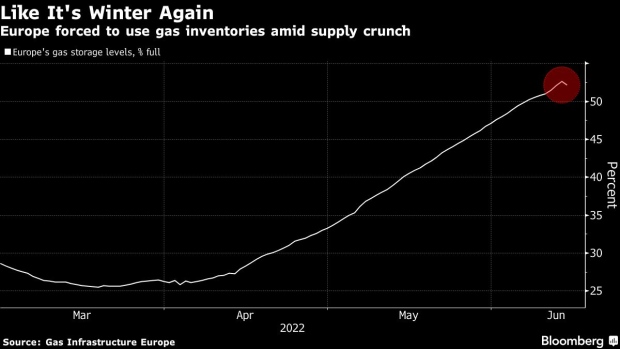Jun 17, 2022
Russian Cuts Force Europe to Use Gas It Was Saving for Winter
, Bloomberg News

(Bloomberg) -- Cuts in natural gas supplies from Russia are forcing European utilities to tap reserves normally used during the peak winter season.
In one of the latest signs of how the region’s energy crisis is escalating, storage levels fell this week for the first time since mid-April, when traders typically start to top up facilities, data from Gas Infrastructure Europe show. That’s helping drive gas futures toward their biggest weekly gain since the Kremlin began its war on Ukraine.
“Clearly this should not be happening in the injection season,” said Warren Patterson, head of commodities strategy for ING Groep NV. “This will be unsettling for the market and is likely to keep prices supported.”
Russia has slashed supplies to customers in Italy, Germany, France and Austria, adding to smaller reductions to other nations in the past few weeks. Moscow said it had to curb capacity on its Nord Stream link under the Baltic Sea because of technical issues, but Germany called the reductions “politically motivated” aimed at pushing up prices.
The cuts by Russia are coinciding with an outage at a major liquefied natural gas plant in the US, another crucial source of European supplies. It means that less fuel will arrive from across the Atlantic for months.
Europe’s storage sites were about 52% full as of Tuesday, with the latest GIE data showing a one percentage point decline. Still, they remain near the five-year average level.
“The biggest challenge facing the market is assessing the impact of the resulting slowdown in storage injections,” BloombergNEF analyst Arun Toora said in a note.
Russian exporter Gazprom PJSC said Thursday that it doesn’t see a solution “as of now” to the Nord Stream issues. Gazprom could use spare capacity on pipelines crossing Ukraine to supply European customers, but hasn’t opted for that yet. The link is also scheduled for an annual maintenance shutdown next month.
In in the worst-case scenario, where the Nord Stream pipeline is shut totally, the region will fail to reach the stockpile levels the European Union has ordered by the start of the heating season in November, according to Wood Mackenzie Ltd. That means the region could run out of stocks completely by January, the researcher said this week.
Hans Van Cleef, a senior energy economist at ABN Amro Bank NV, said he’s “wondering if the annual maintenance for Nord Stream will mean a full stop for longer, or whether it will resume afterward again. Time will tell.”
©2022 Bloomberg L.P.





